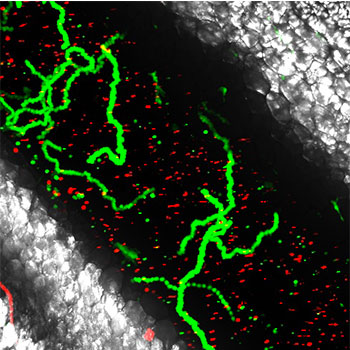No platelets, no immune response

When a virus attacks our organism, an inflammation appears on the affected area which triggers off the process of immune defence within our body. White blood cells (such as neutrophils and inflammatory monocytes) move quickly to the inflamed area. Up until now, it was proved that neutrophils were the first defenders to arrive but today, researchers at the University of Geneva (UNIGE), Switzerland, discovered that their recruitment onsite depend on a group of patrolling monocytes, referred to as “residents”, and also on a protein called CCN1, produced by the platelets and by the endothelium (the blood vessel). Without the latter, the defenders are not recruited to fight off the virus. This discovery, which can be read in the scientific journal PNAS, opens the path to new possible theories regarding antiviral treatments.
When attacked, white blood cells leave the blood circulation and migrate into the tissue around the inflamed area. Neutrophils are the first to be recruited within a few hours, followed by inflammatory monocytes which appear as back-up some time later. Neutrophils are therefore picked up in the area where the endothelium is stressed by the attack. They stick to its wall and then migrate outside the vessel to reach the damaged tissue and to fight against the infection.
When resting, the endothelium is incessantly scanned by resident monocytes in charge of patrolling the smallest part of blood vessels to check all is running smoothly, just like vigilantes. Up until now, the ability of monocytes to patrol blood vessels when the inflammation begins had never been highlighted.
A new protein identified
Researchers of the Pathology and Immunology Department of the UNIGE Faculty of Medecine have wondered about the role of resident monocytes in the onset of inflammation – did they participate in recruiting neutrophils and inflammatory monocytes? Is there a molecule involved in their patrolling job? Yalin Emre, co-author of the study, explains that, ‘Using an intravital microscopy technique, which allows to follow cell activity in the blood in real time, we observed that when resting, the endothelium produces a protein called CCN1 that coats the internal side of the blood vessel. If we block this protein’s activity, all the patrolling work carried out by the resident monocytes is disrupted. Indeed, they then move around much slower along the blood vessel wall and fail to check all the necessary areas. We therefore discovered that CCN1 provides a molecular support allowing resident monocytes to move around efficiently.’
Researchers noticed the importance of the protein CCN1 when resting. But when the organism is attacked by a virus, does it also have a role to play? By creating blood vessel inflammation using an agent mimicking a viral infection on mice, scientists noticed that the amount of CCN1 bound to the endothelium quadrupled in 20 minutes, the number of patrolling monocytes tripled between 30 and 60 minutes whereas neutrophils arrived on the inflamed area 120 minutes after the viral attack started. Yalin Emre adds that, ‘By blocking the CCN1 activity during the inflammation, we noticed that the recruitment of patrolling monocytes and neutrophils stopped, which confirms the importance of this protein’s role during the early steps of inflammation.’ It is the first time we discover that monocytes, in this case patrolling monocytes, react before the neutrophils. But as opposed to neutrophils, they gather on the internal side of the vessel and do not migrate into the surrounding tissue. Instead, these monocytes meticulously patrol along the endothelium and produce molecules in charge of attracting and recruiting the neutrophils.’
The origin of defence action: platelets
It was necessary still to explain how the CCN1 amount quadrupled so quickly after injury. The researcher explains that, ‘Thanks to the intravital microscopy technique, we saw that patrolling monocytes usually have no contact with the platelets at rest. Therefore platelets flow freely in the blood. But once inflammation occurs, platelets directly interact with the patrolling monocytes, and release the CCN1 protein which binds onto the endothelium and which explains this high increase.’ The increase of CCN1 amount is essential both for the recruitment of resident monocytes and for their patrolling activity. In the event of a viral attack and if there are no platelets in the blood, the CCN1 level will not rise, therefore abolishing any recruitment of patrolling monocytes that cannot call upon either neutrophils or inflammatory monocytes. So as Yalin Emre concludes, ‘We have therefore discovered the first element in the recruitment cascade of our immune defences. Without platelets we are helpless in setting up any defence means, at least in the first moments of the inflammation.
CCN1 is therefore essential to both guide the patroller troops and to trigger the immediate immune response in the event of a viral attack. This opens the way to new possible therapies for antiviral treatment as up until now, researchers focused mainly on the cells (lymphocytes, NK cells, neutrophils, macrophages) detected in the infected tissues to attempt fighting off the virus. Today, they will also be able to rest on the role of patrolling monocytes as well as CCN1 and on platelets.
Contact: Yalin Emre +41 22 379 57 35
28 Jul 2016